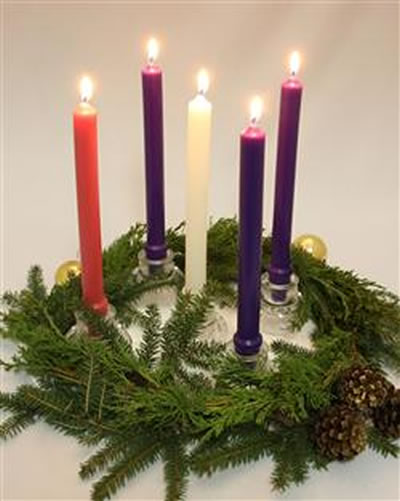

This Sunday is the 1st Sunday of Advent and the first Sunday of a new liturgical year. The word “advent” comes from the Latin word adventus ..arrival …the coming of someone very special.
The Advent season is a season whose liturgical color is purple, the color indicating a time of serious thinking supported by some extra penance. The color purple is the chemical result of the light of the rising sun piercing through the darkness of the night.
Spiritually the symbol of the darkness of life without God since the original sin of the first parents, gradually being pushed back by the light of the coming promised Messiah, the nativity of the Redeemer, the Lamb of God to take away the sins of the world, the Savior, the Way, the Truth and the Life.
This Sunday’s Gospel by St. Luke is basically identical to last Sunday’s by St. Matthew, dealing with the Lord’s return “in power and glory” to rapture His small selected minority of chosen faithful ones, from the undescribable tribulation that a Satan inspired world is ready to bring upon itself and telling us of what the precise signs are of that pending triumphant victory of good over evil.
In the Epistle, we are told “Brethren.. now is the time to wake up from your spiritual sleep …. The time is here to stop doing things that belong to the prince of darkness, not to the prince of light.” A very clear message, and yet, the world around us does not seem to get it.
We cannot escape the fact that there is so much rushing around during this season which most no longer call the Christmas season but simply the holiday season. December has easily become the most hectic and busiest month of the year.
And the sad result is this: Most people are so busy preparing the material aspects of Christmas that before they realize it, Christmas passes and little or nothing spiritual has happened to them inside and the Advent Devil has scored another victory.
Do not let this happen to you and to your children, especially if your family is still blessed with little children. Little children have a natural need to experience wonder. That is why their still wide open minds and souls can so easily be filled with all sorts of monsters and phony angels, demons really of the fair we see in books and TV shows today.
But little children also have a natural need to experience awe and reverence. And it is up to their parents and their grandparents or favorite uncle or aunt, to first feel that awe and reverence themselves, and then, create a mood of awe and reverence which will unfailingly be felt by the children.
Perhaps you have already reconciled yourselves to the fact that we the Christian majority have fallen asleep on the switch of progress and have lost the December recognition of Christmas in our shopping malls, workplaces, restaurants, banks post offices and public buildings.
And to those places where they tell you when you object to no manger scene, that they have a Christmas tree, let me remind you that without a Christmas nativity manger underneath it, and the Star of Bethlehem on top of it, the tree alone, with or without lights, is simply a symbol of the one time pre-Christian pagan ceremonies of the Yuletide.
But besides this little chapel which is your spiritual home, there is still another place where no one can change your upcoming holyday into just a holiday. Where the battle to Keep Christ in Christmas can still be won. That place is your natural home.. your family!
This can be done by keeping some of the old Advent traditions alive in your homes. Develop your own family Advent program by selecting from those traditions that work best for you.
There is the Advent wreath, made of evergreens with 4 candles, preferably 3 purple and 1 pink. The wreath, which is a circle without beginning or end, stands for eternity: God without beginning and without end. The evergreens stand for life and growth. The 4 candles represent both the 4 ages of the Old Testament before the coming of the Messiah, and the 4 weeks before the celebration of Christmas. And there is a beautiful family ceremony which grew up around this wreath.
There is also the Advent calendar with a little window to be opened each day. You can read Christmas stories to the children ans select watching some of the beautiful Christmas programs still around, if not on TV then on tape or DVD. Play and sing Christmas carols. Make sure the manger scene is prominent in your home. And send religious Christmas cards mailed with the religious Christmas stamps.
By doing all this, Advent becomes a time like no other during the year. A time of family communication. Especially communication with your children about something deeper than ;”What am I going to get for Christmas or for the little ones What is Santa Claus going to bring me?
There is nothing wrong with giving Christmas gifts and there is nothing wrong in receiving them either. Provided we do not forget that our expression of human love and affection for one another expressed by our gifts is only in imitation of God’s love and God’s greatest gift to us: Himself, on His human birthday, the first Noel, Christmas in Bethlehem.
Tell your little children the truth. That the giving of Christmas gifts did not originate with a nice round bellied friendly man dressed in red and white we call Santa Claus, but with a real Santa Claus, the saintly priest and bishop, St. Nicholas, who today is alive in Heaven and whose feastday we celebrate December 6th. He lived in Turkey hundreds of years ago and started the custom of giving presents to children to make them happy in celebrating the birthday of the Divine Child, Baby Jesus, on Christmas. You will never have to take this back when your children grow older.
Some of you I am sure have among your Christmas decorations a reproduction of the noted sculptor Rudolf Vargas’ Kneeling Santa. In it we have the 2 major symbols of a child’s Christmas expressing their true relationship, Santa on his knees before his new-born Lord and Savior.
But this is not just for a child but for all of us to whom the Lord unambiguously stated: “Unless you become as little children again, you shall not enter the Kingdom of Heaven.”
This is the real meaning of Christmas. And to prepare for that kind of Christmas is what the Advent season is all about. So let us have a real Advent and we will have a real Christmas!

-
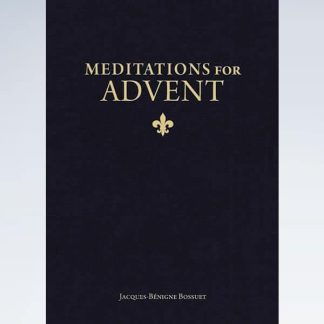 Meditations for Advent by Bishop BossuetUS$ 15.00
Meditations for Advent by Bishop BossuetUS$ 15.00 -
 100% Beeswax Advent Candles 9″ (Set of 5)US$ 44.00
100% Beeswax Advent Candles 9″ (Set of 5)US$ 44.00 -
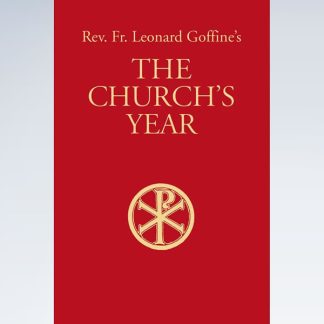 The Church’s YearUS$ 52.00
The Church’s YearUS$ 52.00 -
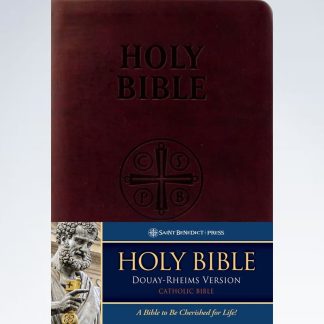 Holy Bible Douay-Rheims Version (Burgundy Premium UltraSoft)US$ 53.00
Holy Bible Douay-Rheims Version (Burgundy Premium UltraSoft)US$ 53.00 -
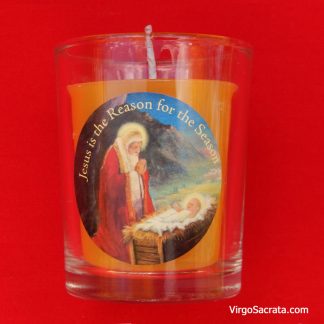 Saint Nicholas Christmas Gift Beeswax CandlesUS$ 33.00 – US$ 59.00
Saint Nicholas Christmas Gift Beeswax CandlesUS$ 33.00 – US$ 59.00 -
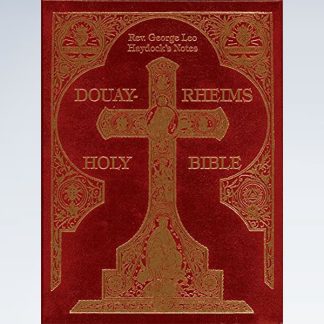 The Haydock Bible with Commentary (The Douay-Rheims Old and New Testament)US$ 150.00
The Haydock Bible with Commentary (The Douay-Rheims Old and New Testament)US$ 150.00
VIRGÓ SACRÁTA is a Christian mission-driven online resource and shop inspired from the beauty of Catholic faith, tradition, and arts. Our mission is to “Restore All Things to Christ!”, in continuing the legacy of Pope St. Pius X under the patronage of the Blessed Virgin Mary. “Who is she that cometh forth as the morning rising, fair as the moon, bright as the sun, terrible as an army set in battle array?” O Mary, conceived without sin, pray for us who have recourse to Thee.


